In the end, four of Council member Mike O'Brien's five amendments to the deep-bore tunnel resolution ended up little grave markers for political transparency. The Port can non-bindingly say it's in for $300 million. The state can stand firmly behind an unfunded transit component. It's late in the game, and it would have been profoundly surprising to find anyone with a change of heart, let alone two or three votes.
"Full speed ahead," trumpets Tim Burgess on his blog, and if you view boldface, assertion, and boldface assertion as successful rhetorical techniques, you can't help but be persuaded. (Winningly, he adds, "The issue of cost overruns has also been resolved.")
The sturm und drang over the prospect of delay on the Alaskan Way Viaduct Replacement project--the bad delay, not the good delay--aside, no one really cares what the Council thinks. It's more the principle of giving the appearance of looking after Seattle's interests. Learning that two-thirds of Seattle residents really do care how much the tunnel may finally cost, the Council went back to the drawing board to look into the benefits of punting....
I was thinking the other day about the poor state of the Obama Administration and how they'd managed to get so much done and yet only lose ground in the process. The problem, as I see it, is the difference between strategy and tactics when it applies to a military campaign.
Strategy is the overall scope of your battle plan. You will take that hill, then push on to the city below. Tactics are the decisions you make in battle. How will you deploy your troops? How will you send them up the hill? Should you use airpower or artillery?
Obama has a master strategy here--fix a whole bunch of problems that have needed fixing for a while, and fix them permanently. The problem is that politics is entirely about tactics, the daily ebb and flow of the battle. And they're getting outmaneuvered on all sides by the political Right, which is fewer in numbers and shoots themselves in the foot every chance they get, but has managed to keep the Obama Administration so harried they fired a USDA executive last week without stopping to consider the story's origin or veracity.
What does this have to do with Mayor McGinn though? Well, he has the same problem. He has a strategy, but he lacks the tactics to get it done, especially in the face of a City Council emboldened by having a political novice in the executive's chair.
Think about his continual sputtering about the Viaduct. He does have a strategy, and it's not a bad one. He's pulling from the playbook of Fabius Maximus, the great Roman general who was maligned for his strategy against Hannibal. Fabius knew that Hannibal was a tactical genius: At Trasimene Lake, the Carthaginians slaughtered a far larger Roman army because Hannibal used the landscape and surprise to force the Romans out of their battle plan, rendering classical Roman tactics completely useless. Fabius knew Rome could not fight Hannibal's war....
"basking away" courtesy of our Flickr pool's :MPG:
It's funny, at one time, the conventional wisdom was the deep-bore tunnel funding bill wouldn't have passed without that "You can barely even see it" cost overrun provision, and people took pride in their sausage-making. Now, on the heels of a poll that showed Seattleites do worry about deep-bore tunnel cost overruns, the City Council and Governor Gregoire made sharp about-faces this week, with the Council adding some heretofore "unnecessary" protective language to its end of the agreement, and Gregoire saying the original cost overrun provision didn't come from her office.
Also, the Seattle Times endorsed I-1053, the initiative requiring a super-majority (or a state-wide vote) on any tax increases. (Ironically, simple majority passage of the initiative is good enough for I-1053 backer Tim Eyman--you'd think he'd insist on a two-thirds majority, out of principle.) In this the Times is partners with BP, who still have enough money left over from working on cleaning up the Gulf to fund initiative campaigns.
BREAKING: Popular sentiment is rising to trade the Seattle Times editorial board for the Sacramento Kings.
On our Capitol Hill, crews were trying out a new kind of sidewalk repair. CD News traced the impact of segregation on Seattle neighborhoods. Eastlake Ave. blog noted, ruefully, that repairs are ongoing for the I-5 Ship Canal bridge. Queen Anne View reported that the TV tower climber has been told to STOP DOING THAT....
The tunnel's southern approach, or, "Acres of Asphalt"
This week, two consultants gave briefings on the deep-bore tunnel planned to replace the Alaskan Way Viaduct: John Newby, P.E., hired by Seattle's City Council, and Dr. Thom L. Neff, hired by Mayor McGinn (video here). Neither man said it would be easy, and neither cared to back up Gov. Gregoire's claim that there will be no cost overruns period.
But apparently it was not within the scope of their inquiry to assess how worthwhile the project is, given the risks. What is the bang for the multi-billion-dollar buck? How does this project's cost/benefit compare with other transportation projects facing the state? Crosscut wants a tunnel vote, but as much as I am dubious about the tunnel project, and despite writing about it for months, I still don't have the information needed for a baseline comparison.
Some very risky projects are worth it. Some aren't. I still maintain that Seattle's decade-long deadlock on the Viaduct's replacement simply indicates that a truly fair, useful, simple solution hasn't been arrived at--largely because leadership insists on "replacing" the Viaduct, rather than better serving the different populations who rely on it. Instead, we're offered a 1.7-mile underground bypass estimated to cost almost $2 billion before anything goes wrong.
"When things go seriously wrong with urban tunnels, the consequences can be significant, leading to long delays, large cost overruns, and extensive 3rd party damages," says Newby's report. Publicola clarifies that--just so there's no confusion--the City Council was informed that there's a 40 percent chance of cost overruns on the $1.96 billion tunnel itself, though the odds incline toward a total of not more than $2.25 billion.
Newby certainly knows firsthand the risks of tunneling; his firm CDM are geotechnical consultants on King County's plagued Brightwater sewage conveyance project. (Here they are discussing in advance how you need to have options besides rescue shafts, given the expense.) "Seattle area glacially consolidated soils have caused significant wear to TBM cutterheads and tools," his report notes. ("Significant" as in "irreparable in situ," in one case that springs to mind. Options? "As of May 1, we have no way to remove it and are still working on a plan," said King County's project manager.)...
Mayor McGinn has handed off a Memorandum of Agreement (between Seattle and the state on the $4.2-billion Alaskan Way Viaduct and Seawall Replacement project) to the City Council. It's probably most remarkable for the fact that neither the Council nor the state seem inclined to read, let alone agree, with its "third way" option. Wrote McGinn in a letter to the Council:
Today I am sending the negotiated agreements between the City and the State, together with some new language for your consideration. This language, which we have included as paragraph 2.11 of the master SDOT agreement, proposes what I call the "third way," and it provides us with a path forward to complete the agreement.
In short, this new contract language would stipulate that Seattle’s agreement to go forward will not take effect unless and until the State amends state law to clarify that the State is responsible for all project funding including cost overruns.
This seems a pro forma move by McGinn. The Council has signaled--mightily--that it has absolutely no problem with the cost overrun provision, and has the numbers to override McGinn's paragraph 2.11. Publicola reports that McGinn didn't bother to discuss his revision with the Council before sending it over.
Council President Richard Conlin, shown laughing and talking with a lobbyist for developers like Vulcan (at an event at Vulcan's Discovery Center), told the Seattle Times an interview over the weekend: "If cost overruns take place, then we'll have to figure it out."
The City of Seattle's general fund is a portrait of neediness. It's carrying about $4 million in red ink from 2009, and is looking at a $7-million shortfall in 2010, thanks to revenues coming in $2 million under projections and $5 million in "expenditure risks" (more on this later). In addition, 2011's forecast keeps coming in $56 million short.
This morning, the Mayor's budget director, Beth Goldberg, briefed the City Council on the steps necessary to balance the budget, with "the bulk coming from police, parks and libraries," sums up the Seattlepi.com. The cuts total $12.4 million (pdf), and an unspecified amount would carry over into 2011, to address that year's looming deficit.
Last week, Mayor McGinn was also looking at the Fire Department for cost savings; after this weekend's fire, which took five lives, cuts are on hold. An investigation into the equipment failure that left the first truck to arrive unable to pump water is ongoing.
Says McGinn: "The tragedy in Fremont this past weekend gave us a concrete example of the importance of protecting our public safety budget; in light of that event, I am not proposing any reductions to the Fire Department, giving us an opportunity to fully review the safety implications of any potential reductions."
That still leaves police (a $2.27 million cut), human services ($246,000), and parks ($1.67 million). The police department will have to do without 21 extra officers promised by the Neighborhood Policing Plan, and the city is "cutting" 53 full-time positions (not hiring for 44 vacancies). McGinn notes that the city is still staffing police officers at record levels.
(More peace officers doesn't necessarily bring more peace and quiet: A man who fired a shot in Belltown last weekend was released after police questioning found he had a permit to carry the weapon. The man claimed he'd fired it to frighten off two other men who'd flashed their guns at him. All in favor of taking advantage of this return to frontier justice and renaming Belltown "Tombstone," say aye.)...
 This segment is on East John St., just before Broadway.
This segment is on East John St., just before Broadway.
Last week, the Mayor and Council member Tom Rasmussen added another chapter to the endless sparring over tunnel cost overruns, and the Council's Tim Burgess announced that it was time to consider an all-out ban on plastic grocery bags. Earlier, in mid-May, the Council committed Seattle to an Arizona boycott. You wouldn't think, with all the cost overruns debate and the getting tough on panhandlers and plastic bags and Arizona, that there was anything more pressing to be done. So I have collected five photographs I'd like them to take a look at.
I have a short bicycle ride, five to ten minutes, across Capitol Hill to my office. This morning I stopped to take photos of the larger potholes on my route. (Parts of 14th Ave. E. are all potholes, but they're smaller in size.) My point is, these are photos of convenience; I didn't stop if traffic was coming, or if the pothole was on the far side of the road. Any of these, if I hit them right, might send me over the handlebars into traffic.
I don't believe the Seattle Department of Transportation is studiously ignoring Capitol Hill--everywhere I go around Seattle I see similar signs of disrepair. There is an SDOT pothole report hotline (206-684-7623, also online), but it's like playing whack-a-mole. The repairs rarely last for long. Even repaved streets don't seem to last for long, especially where there's heavy bus traffic. (I'm not blaming buses--this would suggest to me that the streets aren't being built to withstand heavy bus traffic in the first place.)
In 2006, Seattle voters passed the Bridging the Gap levy, a nine-year, $365-million transportation maintenance and improvements project specifically to catch up on deferred road maintenance. That is in addition to what is already budgeted, of course. Here is photographic evidence of just how well that's working. ...
Coverage of the tunnel project oversight meeting, attended by Governor Gregoire, the Mayor, and the City Council, provides some real whoppers. As expected, the debate grew out of the legislature's provision that Seattle property owners pay for the deep-bore tunnel project's costs if they exceed the budgeted amount of $3.1 billion.
Governor Gregoire has to take top honors for her cherry-picking defense of public project spending. The Seattle Times quotes her as saying:
"Mr. Mayor, we have a track record that's loud and clear. We have a track record of getting every project done on time and on budget," Gregoire said, specifically referring to the Tacoma Narrows Bridge and the recently finished highway ramps in Sodo.
That's right, "every project" means two projects. When the Mayor listed overruns on the Third Avenue bus tunnel, the Brightwater sewage tunnel and the Beacon Hill light-rail tunnel, the Times says Gregoire retorted, "I didn't manage those projects." She also insisted that "delay" is what causes cost overruns, a week after WSDOT announced that building an extra year into deep-bore tunnel project would actually help keep costs down.
Council member Tom Rasmussen also locked horns with the Mayor over the cost overrun provision, arguing that cost overruns are unlikely to occur because the state, planning for cost overruns, built $415 million extra into the project. Now all the cost overruns have to do is conform to projections....
"On Monday," Tim Burgess reminds you, "the Council will reconsider and vote on Council Bill 116807, the aggressive solicitation measure the Council adopted 5-4 on April 19, 2010. Mayor McGinn vetoed this legislation on April 26, 2010, and returned it to the Council."
The odds are not good. By Burgess's reckoning, in the past 20 years there have been eight mayoral vetoes and only two have been overridden by the City Council, thus far. Personally, if Burgess's revamped bill stands legal scrutiny, I don't think a trial period is out of line, though the Council majority seems to have jumped at the chance to grandstand in favor of keeping a more punitive law on the books.
But this raises the question: What's such a big deal that the Council will override a mayoral veto?
One, increasing staff hourly wages and the salary of the Executive Director of the City Employees Retirement System. Two, self-cleaning public toilets. "Since the 1980s, Seattle business owners have said the lack of public restrooms was the top issue facing downtown," noted the P-I. (Now the top issue is public safety--public restrooms aren't mentioned at all in the Downtown Seattle Association's list of goals and priorities, despite no progress being made on that once all-important front.)
The Council (Jan Drago and Nick Licata leading the charge) would not take Paul Schell's veto for an answer, and in August 2001 directed "Seattle Public Utilities to enter into a contract for the lease, installation and maintenance of five automatic public restrooms."...
(h/t Publicola) City Council President Richard Conlin needs to work harder on believing impossible things. The Queen in Alice and Wonderland can do six before breakfast, and he gets stuck on just one: believing the state would really make Seattle pay for deep-bore tunnel cost overruns.
In his post "Time to tell the truth about costs and the viaduct tunnel project," he says the risk of cost overruns is an "exaggeration and serves solely to instill fear and doubt" and calls upon Mayor McGinn to "publicly announce that he will do everything in his power to keep the project moving." Since the legislative intent was to shift all responsibility for cost overruns to "Seattle property owners" (with no upper limit), I'm not sure how Conlin is defining "risk" and "exaggeration."
McGinn's made a public announcement, but it's not quite what Conlin was hoping: "I think it is time that Richard and I air these issues and talk them through in a public forum. A debate like this between us will give the public a chance to decide for themselves whether or not we should worry about cost overruns."
Conlin spends a whole paragraph on what he characterizes as the unenforceable state legislature provision that targets Seattle property owners who benefit from the tunnel:
First, the legislation limiting the state’s responsibility says nothing about the City, but instead makes a legally meaningless reference to property owners. In addition to being vague, the statement that names ‘Seattle area property owners’ as responsible for cost overruns has no legal teeth to compel the City to assume cost overruns for a project that the state is managing.
But in the paragraph immediately succeeding that one, he writes: "Yes, the state could take future legislative action to force the city to pay for overruns," appending to that admission the disclaimer, "but this scenario would set a terrible precedent for all Washington cities and an honest political assessment suggests that such a move would never be approved." Just for the record, the first part is a fact. The second part is an assumption....
When Mayor McGinn reaffirmed his intention to veto any city agreement with the state that left Seattle on the hook for cost overruns for the deep-bore tunnel, the City Council, which voted unanimously last year to leave Seattle exposed to unlimited cost overruns, was apoplectic.
"Grandstanding," said Richard Conlin, whose green credentials apparently extend only to composting. (He's worried about delaying the new, higher-car-capacity 520 bridge, too.)
The Seattle Times quotes the council's transportation chair Tom Rasmussen saying direly, "I think it's a dangerous game. I think it's harmful. It's disingenuous." It seems the council, facing a budget deficit, thinks that it's better to hire "lawyers and other experts to make sure the city is protected in that contract from cost overruns," rather than simply demand the Legislature remove the provision.
While widely reported as new news, McGinn has repeated his refusal to accept cost overruns and sketchy financing early and often since he ran for mayor. How the deep-bore tunnel would be funded was his concern back in July '09, when the city had agreed it "would levy a parking tax, increase utility fees, and use any federal grant or economic stimulus money earmarked for transportation on the project," to raise its share totaling $930 million.
In August of '09, McGinn's campaign site was arguing about the cost overrun provision specifically, and noting that "the Seattle share of tunnel costs nearly equals the total of every other voter-approved levy in the city." In October came the city council's inexplicable, unanimous agreement with the state approving Seattle's responsibility for cost overruns. Only Nick Licata seemed to realize what a horrendous decision this was, but the City Attorney assured him the agreement was "more like guidelines."...
Photo: Ryan Hawk/Woodland Park Zoo
The meerkats are coming! May 1 is the date for their cute blitzkrieg on the Woodland Park Zoo.
Eight Rikki-Tikki-Tavi relatives will take over a newly renovated exhibit in the zoo's Adaptations Building. They've been away for ten years, and now they're returning to settle old scores by zooming along tunnels or poking their heads out curiously with their WIDDLE NOSES!
Now, back to hard-nosed news. Underwater? Scrambling to pay the mortgage? If only you could "strategically default," like the owner of the Columbia Tower, plus nine other office towers and buildings in Seattle and Bellevue, as reported in the Seattle Times.
With office rents plummeting due to an almost 20 percent vacancy rate in Seattle, Beacon Capital Properties says its rental income covers (after expenses) covers only 20 percent of its loan payments.
The Teamsters threw an on-again, off-again strike to protest Waste Management, Inc., raising their share of health insurance costs. You'd think garbage collection was a stable revenue stream, but I checked WMI's annual report and revenue fell about 15 percent last year. You know what didn't? Health insurance costs.
Down at City Hall, the Mayor vetoed the anti-aggressive-panhandling bill, after a 5-4 City Council vote in favor. All nine members of the Council signed on to a firmly worded letter to the Mayor, asking him to lift a hiring freeze on new police officers. McGinn, on KUOW, said the Council had passed an unbalanced budget. (Nyah, nyah.) So that's going well. Image-wise, everyone comes out wearing the same size clown shoes. In the meantime, here's SeattleCrime.com's map of where you can go to get robbed.
In other testy government-epistle news, the Sustainable 520 Coalition sent a letter to the Governor laying out the grounds for redesigning 520's replacement to carry light rail from day one. Washington's rich people have had it with the spineless legislature! If they won't pass a high-earner's income tax, they'll do it by initiative. If BNET's crystal ball isn't cracked, we're incubating a substantial increase in new jobs over the next ten years. Group Health Credit Union is changing its name to Salal Credit Union. Huh....
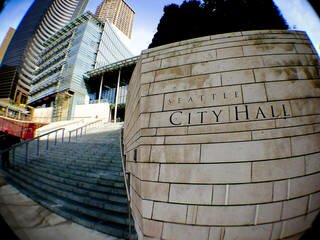 City Hall, as seen by our Flickr pool's Slightlynorth
City Hall, as seen by our Flickr pool's Slightlynorth
Next Monday, the full City Council will vote on council member Tim Burgess's revised aggressive solicitation ordinance (pdf). Last week, the ordinance passed out of committee by a 3-1 vote (Burgess, Conlin, Bagshaw, aye; Licata, nay). Argued Nick Licata at the time: "Aggressive panhandlers are regularly convicted under Seattle's current law." That's not good enough, says Burgess, who invokes Malcolm Gladwell in declaring that Seattle's street disorder is near "a tipping point."
It's a controversial ordinance, but after the initial questions have been raised--Will this target the simply homeless? How precisely and fairly will it be enforced?--what you're struck by is that ex-policeman and detective Burgess (1971 to '78) is trying to reinvent policing style from outside the precinct walls. He writes on his blog:
At a broader level, there are two policing strategies that I hope our police commanders will embrace wholeheartedly--concentrated deterrence and re-asserting community norms against violence and disorder.
Concentrated deterrence is built on the Pareto principle, or the 80/20 rule, popular in business. There, it suggests that 80 percent of your business comes from 20 percent of your clients. Burgess would simply substitute "crime" and "criminals" for business and clients. He notes that when Seattle police targeted the most active car thieves locally, car theft fell by 66 percent between 2005 and '08....
"Traffic on 520" courtesy of SunBreak Flickr pool member Great_Beyond
UPDATE: Here's Mayor McGinn's blogging on the subject.
After almost 13 years of design and a legislative mandate that the replacement 520 bridge "shall also be designed to accommodate light rail in the future," it turns out that that depends on what you think "bridge," "design," "accommodate," and "light rail" mean.
Really, no one anticipated running light rail on 520, so far as I can tell. After a lot of political heavy lifting to get light rail on I-90, people thought, "Whew! That's done!" and went home. As few as five year years ago, the response to light rail on 520 was still, "I-90 will have it." Very much like light rail was a grudging political gift, rather than a practical transportation solution, or part of a larger strategy.
The defeat of Roads and Transit in 2007, in favor of simply transit, marked a sea change. A majority voted down a roads and vestigial-appendage transit plan, and then voted for a significant transit-only package. Now a meaningless, campaign-promise line like "shall also be designed to accommodate light rail in the future" was a hot potato. Because of course the replacement 520 was not designed to accommodate light rail, except "in the future," when money will apparently grow on trees.
Seattle Transit Blog says it all comes down to "the difference between 'physically being able to carry trains' and 'accommodating light rail.'" The bridge is designed not to sink, yes, if you add pontoons before putting a train on it. But it isn't designed for the train to get on or off. "The cost and disruption would be so great that a retrofit of these changes is practically infeasible, meaning that light rail would never cross 520 even if all of the transportation experts said it should." (It's worth noting--if you suspect STB of an unappeasable desire for light rail--that they are not agreed on the need for light rail on 520.)...
Seattle Center is holding a "Fun Forest Redevelopment Public Hearing" in the Center House, Conference Room A, tonight at 6:30 p.m. Most of you dodged an earlier solicitation for public input, so they're doing it again, using the heated public reaction to the Wright family's Chihuly glass house proposal as a motivator.
While it's your golden opportunity to chime in about the Fun Forest space south of the Monorail, the Center is also interested in public suggestions for events, art installations, and community gatherings that could be held in what they're calling the Center Square, the three acres north of the Monorail, where the Fun Forest's larger rides used to be.
The only hitch is that the use is temporary--at the end of 2011, the Center will need the Center Square back for their 50th Anniversary celebration in 2012. Otherwise, redevelopment of the north space is all planned out: Center spokesperson Deborah Daoust says there'll be a large tent for concerts, a 3,500-sq.-ft. children's garden, a basketball court, and a hay bale maze. They're also taking over the Center Square Pavilion, a 7,000-sq.-ft. building adjacent to the Center House's east side that I remember mainly for having an ice cream shop with exactly the same choices as those inside the Center House.
For the south area's redevelopment, Daoust says the future of the 1.5 acres is being opened up to an RFP process, to see if members of our outraged public can come up with a better idea than the Wrights'. Meanwhile, the Fun Forest's "kiddie rides" will remain in place until Labor Day 2010....
Yesterday, Mayor McGinn sent the City Council his proposal for a $243-million seawall bond measure on a special May ballot. Said McGinn:
We have a responsibility to address basic public safety risks. I have directed SDOT to accelerate replacement of the seawall. I look forward to working with the Council on the financing for this critical work.
To up the ante, the Mayor's office also noted that the accelerated schedule would create a "funding gap of nearly $20 million in 2011 for the Seawall Replacement Project." If work on the seawall is to accelerate in an uninterrupted fashion, the money would need to be scrounged up this year.
Said the Council: "How's never? Will never work for you?"
Publicola quotes Council president Richard Conlin as saying:
When you come up with these big projects, you can’t just say one day, "Hey, we’re going to do this," then the next day say, "No, wait, now we’re going to do something else." Our voters have been very willing to vote for things in the past, but we think that’s been the case because we’ve prepared the groundwork first.
I'm sympathetic to Conlin's position, but it should in no way be confused with reality. Should that be case, we might well imagine Conlin having giving his quote from the voter-approved Monorail, perhaps looking out over an expanse where two voter-unapproved stadiums do not sit.
In any event, the earliest the Council could get around to getting something on the ballot is likely November, adds Conlin.
Now I need to leave off writing this post to read Jordan Royer's Crosscut article, "City Council: Does process still outrank product?"
 This photo has nothing to do with Sand Point.
This photo has nothing to do with Sand Point.
This just in over the e-wire: "In a letter sent today to U.S. Commerce Secretary Gary Locke and Under Secretary Jane Lubchenco, Mayor Mike McGinn and the Seattle City Council argued that consolidating NOAA’s operations in Seattle at existing federal facilities is the best option for NOAA to achieve its mission and the best deal for federal taxpayers."
(Note to the Mayor: My mother would prefer you went by Michael, at least on official documents.)
The Seattle sites up for NOAA grabs are the Western Regional Center at Sand Point and Federal Center South, both conspicuously not located in a floodplain. (Due to pressure from, well, everyone outside of Newport, OR, but specifically a protest from the Port of Bellingham, NOAA has had to go back and prove the necessity of leaving Seattle to build in Newport, which is in floodplain territory.)
There are real heavyweights involved here--NOAA provides employment for 1,200 people, directly and indirectly, and is said to pump about $180 million in economic activity into the area. That's why we're presented with the unusual sight of the International Association of Machinist Local 160 linking arms with the Laurelhurst Community Club.
NOAA's reassessment should finish up by the end of May 2010.
The future of light rail in Bellevue is all over the map. Sound Transit's $2.8 billion East Link line would head east from the ID Station, travel across I-90 and Mercer Island, then swing up to Bellevue before shadowing 520 to Redmond. But the devil is in the details.
Surrey Downs and the Mercer Slough neighborhoods are both convinced light rail ought to run elsewhere. Rookie Bellevue City Council member Kevin Wallace, whose company owns about $50 million in properties along proposed light rail routes, is pushing for light rail to skip downtown entirely.
The Seattle Transit Blog, naturally, has been reporting on developments, but this morning they posted an open letter to the Sound Transit Board and Bellevue's mayor and city council, that goes the full wonky. It's full of walkshed charts and rational argument about crippling a $2.8-billion investment to "save" money. It also, unintentionally, illustrates why people have such a hard time figuring out what's going on with transportation plans. My favorite passage...
After three years of dispute, Seattle Children’s Hospital and the Laurelhurst Community Club presented an agreement to the Committee on the Built Environment at City Hall today. The upshot is that Children's gets to add the 350 beds it was looking for (for a total of 600), while accepting stricter limits on its development.
Now, the Master Plan approval is in the City Council's court, and with the LCC on the sidelines, it should be an easy lay-in. Final deliberation should take place beginning February 25.
To get LCC buy-in, Children's agreed to limit the main campus's total square footage to 2.125 million square feet, with a maximum building height of 140 feet (also limited to a percentage of the footprint). Children's property on the other side of Sand Point Way will not be developed, and in fact, the hospital agreed not to expand into residential areas for 50 years.
Much of this looks like actual compromise. Maybe we can get Children's and the LCC to weigh in on 520 and the Viaduct replacement.
Part of the ammunition Mayor Mike McGinn brought to his City Council briefing on the seawall replacement [video] were the results of a poll he had conducted on the public's willingness to fund it. Of the 1,001 people who were asked this question:
This May, voters will decide a property tax measure to fund replacement and seismic improvements to the downtown seawall, built by city engineers in 1934. The measure authorizes property taxes of up to two hundred forty one million over thirty years, at approximately twelve cents per thousand dollars of assessed valuation.
If the election were today, would you vote yes to approve, or no to reject this excess levy?
70 percent said yes, 19 percent said no, and eleven percent were undecided. The margin of error is plus/minus three percent. That 70 percent is important because the property measure that McGinn is proposing requires a 60 percent approval rating. At $0.12 per $1,000 of property value, it would raise $241 million.
McGinn argued to the Council that the response to "What's the hurry?" is not just public safety, but is related to the depleted city coffers as well. In a letter, McGinn wrote:
Until further funding is secured, financial constraints will limit design and permit work. In 2010, $8.3 million was appropriated for design and permit work. While it is difficult to estimate the precise cash flow impact of accelerating the seawall project, SDOT estimates that an additional $3 million will be needed to cover the additional design and environmental review for 2010....
(more)
In a Crosscut story on Mayor McGinn's surprise seawall announcement last week, former mayor Charles Royer said, "I believe him when he says it is a security and safety issue, because that is what the engineers were telling me in 1985." A 2003 civil engineering paper backs Royer up, saying that the need for a new seawall has been known "for twenty years."
But since the Nisqually earthquake in 2001, seawall repair was moved from the back burner, if not exactly to the front burner. In the November 8, 1934, Engineering News Record, which looked into construction of the first seawall, several challenges were detailed: "the high cost entailed by the physical problems of soft bottom, and a 16-ft tide range, with the attendant marine-borer menace to timber construction." These naturally resurfaced with the prospect of repair.
But then as now, you can't engineer politics. So nine years later, when the Mayor suggests moving seawall construction up by two years, you can read this response on City Council member's Tim Burgess's blog: "Elliott Bay Seawall: Questions to Ponder." What you will learn is that nine years after city leadership was confronted with a significant chance of catastrophic failure of the seawall:
- We don't know what it will cost or look like,
- don't know who will pay for it,
- and don't have a construction process mapped out....
(more)
 We have Paul Swortz, from The SunBreak Flickr photo pool, to thank for this eye candy.
We have Paul Swortz, from The SunBreak Flickr photo pool, to thank for this eye candy.
Let's begin with the week in technology: RealNetworks' CEO Rob Glaser stepped down suddenly; TechFlash owned the story, and has a "What they're saying" round-up.
Microsoft made the Google v. China news twice: The hackers exploited an Internet Explorer flaw and then Microsoft's Steve Ballmer said he "didn't get" what all the fuss was about. (In one sense, there's no arguing with that statement: there is absolutely nothing out of the ordinary about hackers tunneling in through IE.)
Zillow is third in real estate websites, and Redfin surged into the top 20, at 18. The "Baby Einstein" people are suing the UW researchers who noticed a distinct lack of Einsteins so far.
On the political front, Mayor McGinn announced he'll try to speed up the Alaskan Way seawall replacement, and the governor said (I'm paraphrasing): That's nice, dear, we're still building a tunnel. The City Council--who'd earlier announced publicly they didn't trust the Mayor--were miffed at not being properly notified. This is the same City Council who unanimously approved the "blank check" Viaduct replacement plan that leaves Seattle taxpayers on the hook for all cost overruns.
In transportation news, a bunch of people took off their pants and rode the light rail. You can still get a free ORCA card (until March 1) thanks to an extension. 330,000 cards have been handed out so far. The Seattle Times properly raps Sound Transit for making the elderly and disabled wait in long lines to get their ORCA card--Seattlest mentioned what a hassle it is last July....
(Thanks to West Seattle Blog for sharing their video.)
Saying public safety demands it, Mayor Mike McGinn announced yesterday that he intends to speed up replacement of the seawall, and will use a ballot measure to ask for a $250 million 30-year bond. The bond would increase property taxes by 12 cents per $1,000 of assessed property value.
Over half of the seawall that holds back Alaskan Way is compromised, and the rest of it is not in confidence-inspiring condition either: a section of sidewalk collapsed in May 2009, trapping a man.
The seawall was built over time between 1916 and 1936 so that freight could get right to the piers for loading and unloading. Gribble-infested timber platforms act as--less and less--as an anchor for the steel and concrete atop them. Another timber platform, buried thirteen feet deep and about sixty feet wide, holds the fill dirt and material that was dumped to create a level surface. Any significant earthquake would cause the seawall to fail catastrophically, and likely bring down the Viaduct with it.
In fact, it is probably not a good idea to have crowds of people jump up and down on it at the same time. Yet, as with the Viaduct itself, the danger to public safety it represents has not resulted in much nonverbal action. At the outset, it seemed to make sense that the seawall, which was in worse condition than the sagging Viaduct, could be replaced along with the Viaduct, in a year or two....
What is it about being a proponent of the deep-bore tunnel that so often creates the impression that you're still rehabilitating from a nasty stroke? (This is not to say there aren't reasonable tunnel advocates--just that they aren't well-quoted.) This morning's Seattle Times brings an go-go-gadget-tunnel editorial aside that is dumbfounding in its logical discontinuity.
Sadly, the person coming off non-compos mentis, momentarily, is City Council member Sally Clark, who otherwise impresses with her grasp of the issues. Here, she is is defending the Council spending $15,000 on its own lobbyist, rather than rally behind the McGinn administration.
"We don't trust him on the viaduct," said Councilmember Sally Clark. "None of us wants to give the idea (to Olympia) that there is any kind of debate left on this decision."
As Sally Clark surely knows, there is sometimes nothing but debate on the tunnel decision. I suspect that what she means to say is that the Council is no longer debating the decision--which creates a representative gulf between them and the rest of Seattle. (I recall James Surowiecki writing: "The important thing about groupthink is that it works not so much by censoring dissent as by making dissent seem somehow improbable.")
The truly disturbing disconnect, though, is that while the Council is spending extra money on appearing a united front for Seattle--when five minutes with Google provides ample evidence to the contrary--the Legislature itself is divided. As I've written before, there's a profound Olympian schism that means, far from being a "done deal," there is no agreement on how the tunnel will be paid for....
 Trees at risk: each year, 200,000 trees just like the ones in this grove, go to the blade for junk mail.
Trees at risk: each year, 200,000 trees just like the ones in this grove, go to the blade for junk mail.
When the U.S. Congress passed the National-Do-Not-Call-Registry into law in 2003, and improved it in 2007, it became one of the most popular government programs in our nation's history. Almost overnight, the Registry stopped millions of obnoxious calls from interrupting the average American's dinner or Saturday morning sleep-ins. It wiped out the most intrusive, unwanted, and annoying communications development since Alexander Graham Bell implored Watson to "Come here, I want to see you."
I say nearly, because the DNCR left a few loopholes that continue to annoy us all. Exemptions for non-profit organizations and political calls continue to be allowed. This is a problem, but make no mistake: The Registry has been a stunning success that's allowed many of us the chance to eat our meals in peace.
Now the Seattle City Council has the chance to right a litany of wrongs when they vote on a resolution to petition the state legislature to ban junk mail. The council will vote for the resolution to create a Do-Not-Mail-Registry on January 11.
I could reel off a massive list of environmental reasons it's a good idea. The appropriately, and somewhat humorously-named group ForestEthics sent around a blast email to local media chock full of the "environmental impacts" of the local junk mail trade. For the ultimate guilt trip, consider these factoids:
- Almost 200,000 trees are cut for Seattle's junk mail every year
- Junk mail sent to Seatteites causes global warming gases equal to almost 6,000 cars, due to logging and industrial emissions
- It costs more than $400,000 a year to dispose of Seattle's junk mail.
That cleanup total, by the way, is paid by us through taxes. So every day my wife pulls the junk mail out of the mailbox and throws it into the recycle bin in one deft move, it's costing us money....
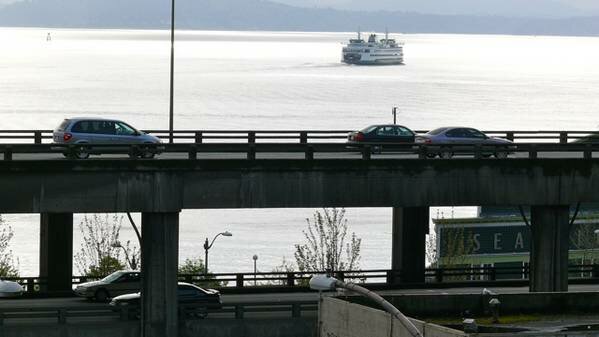
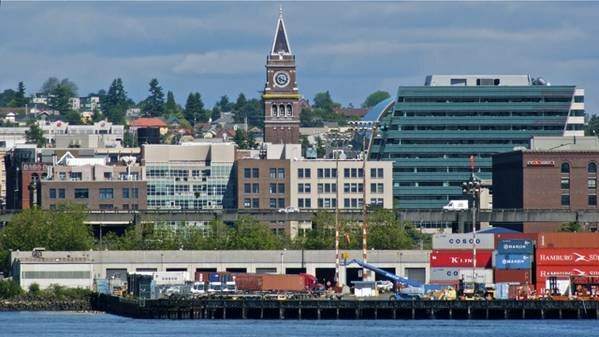
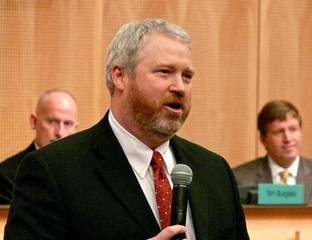
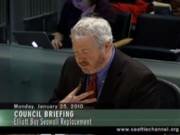

Most Recent Comments